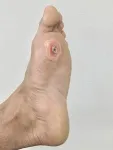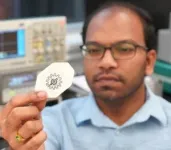(Press-News.org) Researchers have developed an inexpensive bandage that uses an electric field to promote healing in chronic wounds. In animal testing, wounds that were treated with these electric bandages healed 30% faster than wounds treated with conventional bandages.
Chronic wounds are open wounds that heal slowly, if they heal at all. For example, sores that occur in some patients with diabetes are chronic wounds. These wounds are particularly problematic because they often recur after treatment and significantly increase the risk of amputation and death.
One of the challenges associated with chronic wounds is that existing treatment options are extremely expensive, which can create additional problems for patients.
“Our goal here was to develop a far less expensive technology that accelerates healing in patients with chronic wounds,” says Amay Bandodkar, co-corresponding author of the work and an assistant professor of electrical and computer engineering at North Carolina State University. “We also wanted to make sure that the technology is easy enough for people to use at home, rather than something that patients can only receive in clinical settings.”
“This project is part of a bigger DARPA project to accelerate wound healing with personalized wound dressings,” says Sam Sia, co-corresponding author of the work and professor of biomedical engineering at Columbia University. “This collaborative project shows that these lightweight bandages, which can provide electrical stimulation simply by adding water, healed wounds faster than the control, at a similar rate as bulkier and more expensive wound treatment.”
Specifically, the research team developed water-powered, electronics-free dressings (WPEDs), which are disposable wound dressings that have electrodes on one side and a small, biocompatible battery on the other. The dressing is applied to a patient so that the electrodes come into contact with the wound. A drop of water is then applied to the battery, activating it. Once activated, the bandage produces an electric field for several hours.
“That electric field is critical, because it’s well established that electric fields accelerate healing in chronic wounds,” says Rajaram Kaveti, co-first author of the study and a post-doctoral researcher at NC State.
The electrodes are designed in a way that allows them to bend with the bandage and conform to the surface of the chronic wounds, which are often deep and irregularly shaped.
“This ability to conform is critical, because we want the electric field to be directed from the periphery of the wound toward the wound’s center,” says Kaveti. “In order to focus the electric field effectively, you want electrodes to be in contact with the patient at both the periphery and center of the wound itself. And since these wounds can be asymmetrical and deep, you need to have electrodes that can conform to a wide variety of surface features.”
“We tested the wound dressings in diabetic mice, which are a commonly used model for human wound healing,” says Maggie Jakus, co-first author of the study and a graduate student at Columbia. “We found that the electrical stimulation from the device sped up the rate of wound closure, promoted new blood vessel formation, and reduced inflammation, all of which point to overall improved wound healing.”
Specifically, the researchers found that mice who received treatment with WPEDs healed about 30% faster than mice who received conventional bandages.
“But it is equally important that these bandages can be produced at relatively low cost – we’re talking about a couple of dollars per dressing in overhead costs.” says Bandodkar.
“Diabetic foot ulceration is a serious problem that can lead to lower extremity amputations,” says Aristidis Veves, a co-author of the study and professor of surgery at Beth Israel Deaconess Center. “There is urgent need for new therapeutic approaches, as the last one that was approved by the Food and Drug Administration was developed more than 25 years ago. My team is very lucky to participate in this project that investigates innovative and efficient new techniques that have the potential to revolutionize the management of diabetic foot ulcers.”
In addition, the WPEDs can be applied quickly and easily. And once applied, patients can move around and take part in daily activities. This functionality means that patients can receive treatment at home and are more likely to comply with treatment. In other words, patients are less likely to skip treatment sessions or take shortcuts, since they aren’t required to come to a clinic or remain immobile for hours.
“Next steps for us include additional work to fine-tune our ability to reduce fluctuations in the electric field and extend the duration of the field. We are also moving forward with additional testing that will get us closer to clinical trials and – ultimately – practical use that can help people,” says Bandodkar.
The paper, “Water-powered, electronics-free dressings that electrically stimulate wounds for rapid wound closure,” will be published Aug. 7 in the open-access journal Science Advances. The paper’s co-authors include Henry Chen, an undergraduate in the joint biomedical engineering department at NC State and UNC; Bhavya Jain, Navya Mishra, Nivesh Sharma and Baha Erim Uzunoğlu, Ph.D. students at NC State; Darragh Kennedy and Elizabeth Caso of Columbia; Georgios Theocharidis and Brandon Sumpio of Beth Israel Deaconess Medical Center; Won Bae Han of Korea University and the Georgia Institute of Technology; Tae-Min Jang of Korea University; and Suk-Won Hwang of Korea University and the Korea Institute of Science and Technology.
This work was done with support from the Defense Advanced Research Projects Agency under grant D20AC00004 and from the Center for Advanced Self-Powered Systems of Integrated Sensors and Technologies at NC State, which is funded by National Science Foundation grant 1160483. Bandodkar and Kaveti are inventors on a patent application related to this work.
END
Electric bandage holds promise for treating chronic wounds
2024-08-07
ELSE PRESS RELEASES FROM THIS DATE:
Researchers unlock life history secrets of Jurassic mammals using X-ray imaging
2024-08-07
A new study published in Science Advances reveals how early mammals grew and developed during their pivotal Jurassic radiation. Using a technique called synchrotron X-ray tomography to image growth rings in fossilised tooth roots, the researchers were able to estimate lifespans, growth rates, and even the timing of sexual maturity in these ancient creatures.
“This is the first time we've been able to reconstruct the growth patterns of these early mammals in such detail,” said Dr Elis Newham, a Postdoctoral Research Associate ...
Studying how serotonin alters locust’s sense of smell
2024-08-07
By Leah Shaffer
Researchers at Wash U have spent the better part of the decade studying the ins and outs of how locusts smell, including how odors affect the insect’s behavior.
In research recently published in eLife, Barani Raman, a professor of biomedical engineering at the McKelvey School of Engineering, starts to map out just how olfactory circuits are altered in driving different behavior in locusts. Neuromodulator serotonin is a key factor in triggering how locusts can go from being a “loner” to “gregarious” — otherwise known as swarming ...
Physician-scientist named Academy of Immuno-Oncology fellow
2024-08-07
Immunotherapy pioneer Dr. Antoni Ribas, professor of medicine at the David Geffen School of Medicine at UCLA and director of the tumor immunology program at the UCLA Health Jonsson Comprehensive Cancer Center, has been inducted into the 2024 Class of Fellows of the Academy of Immuno-Oncology by the Society for Immunotherapy of Cancer.
The recognition is one of the highest honors bestowed by the society and is given to scientists who have made seminal contributions in the field of cancer immunotherapy.
Ribas, an internationally renowned physician-scientist, has dedicated his career to improving the lives of people with cancer worldwide. His discoveries have led to the development of ...
How media impacts digital technology adoption in U.S. and Brazilian agriculture
2024-08-07
URBANA, Ill. -- Digital technologies on the farm improve efficiency, productivity, and profits, but few farmers are taking full advantage of available tools. According to University of Illinois Urbana-Champaign researchers, communication channels play an important role in farmers’ decision-making process around technology adoption. A new study in the journal Agriculture looks at how traditional media, social media, and interpersonal meetings influence soybean farmers in the U.S. and Brazil, both world leaders in soybean production.
“Like everyone ...
New Center of Excellence at Chapman University will study quantum theory and the nature of reality
2024-08-07
An interdisciplinary team of scholars have received a $2.43 million dollar grant from the John Templeton Foundation to create a “Southern California Quantum Foundations Hub” at Chapman University. This unique collaboration includes theoretical physicists, experimental physicists and philosophers, who will apply the methods of their respective disciplines to provide deeper insights into the nature of reality that quantum theory is silent about. The Templeton Foundation has identified the area of quantum foundations ...
Breakthrough study reveals molecular subtypes of Down syndrome, offering insights for personalized medicine approaches
2024-08-07
A new study published in Nature Communications by researchers from the Linda Crnic Institute for Down Syndrome (Crnic Institute) at the University of Colorado Anschutz Medical Campus reports a significant breakthrough. The research, part of the ongoing Crnic Institute Human Trisome Project, identifies distinct molecular and immune subtypes across individuals with Down syndrome, offering new insights that could lead to personalized medicine approaches for the clinical management of this condition.
The Crnic Institute team analyzed the expression of genes encoded on chromosome 21, which is triplicated in those ...
Biophysical Society announces the results of its 2024 Elections
2024-08-07
ROCKVILLE, MD – Karen Fleming has been elected President-elect of the Biophysical Society (BPS). She will assume the office of President-elect at the 2025 Annual Meeting in Los Angeles, California and begin her term as President during the 2026 Annual Meeting in San Francisco, California.
Fleming is a Professor of Biophysics at Johns Hopkins University. She earned a Bachelor of Arts from the University of Notre Dame before going on to achieve a PhD in Biochemistry and Molecular Biology from Georgetown University Medical Center. In addition to her commitment to research, Fleming has dedicated significant time ...
Better understanding cerebral palsy pain types could lead to better treatment
2024-08-07
Pain management is an important component of caring for adults with cerebral palsy.
However, it's the least understood comorbidity in the adult cerebral palsy population.
A study led by Mark Peterson, Ph.D., M.S., FACSM, a professor of physical medicine and rehabilitation at University of Michigan Health, found that adults living with cerebral palsy had a very high occurrence of pain, with 90% having a pain history and 74% having multiple diagnoses of pain coming from different origins such as the lower back, irritable bowels, joint arthritis and chronic ...
How ribosomes in our cells enable protein folding
2024-08-07
Scientists at UCL have discovered a novel role played by ribosomes during the folding of new proteins in cells, described in their paper in Nature.
Ribosomes, the cell’s dedicated molecular machines for protein synthesis, make all proteins in life and do so by piecing together one amino acid building block at a time. As they are being synthesised, these nascent proteins simultaneously attempt to fold while still associated to their parent ribosome, referred to as co-translational protein folding.
Understanding how exactly ...
Asthma emergencies spike when allergenic pollen blooms
2024-08-07
ITHACA, N.Y. – A new Cornell University study that tracks how many asthma-related emergency room visits result from pollen in metropolitan areas highlights the importance of knowing local plants and the need for developing science-based pollen forecasts.
Such forecasts could alert vulnerable individuals on days when they should consider staying indoors or taking allergy medications ahead of time.
“Even though the percent of asthma-related emergency department visits associated with pollen overall was only a few percent on an annual basis, ...


